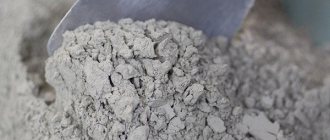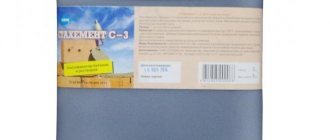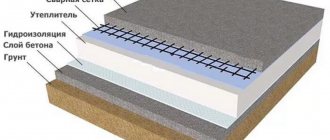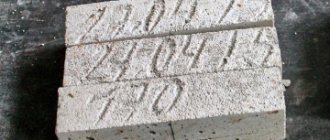Portland slag cement has been used in many areas of construction for almost 200 years. This building material is widely used when constructing above-ground, underground and underwater buildings. Slag cement is a cementitious hydraulic component that is obtained by grinding cement clinker, gypsum and granulated slag.
What is cement with slag? For a long time, granular elements were considered waste, but practice has proven that slag concrete is lighter and more durable. Thanks to materials from the secondary production of waste from the metallurgical industry, gypsum or clay combined with cement make the structures more durable.
Peculiarities
Slag-alkali cement is made using alkali metals. High strength indicators were obtained by adding various alkaline materials - soda, glass.
Portland cement with cinder block is widely used in the construction of reinforced concrete structures, the performance requirements of which must be resistant to aggressive chemical substances. These concrete mixtures are indispensable for the installation of monolithic buildings. When Portland cement is used in the construction of large elements, a large amount of heat is generated in the process and at this moment the temperature reaches up to 80 degrees C. If the structure is cooled in a short period, there is a possibility of the formation of deformation cracks. Slag-alkaline concrete does not allow such a problem to arise.
The most common class of Portland cement, with slag, is based on a combination of alkali metal with Calcium hydrosilicate, hydroalumina silicate and crushed metallurgical slag. Structures made from such building materials have minimal porosity. High quality minimizes water absorption and increases resistance to low temperatures. After 24 hours, the building material reaches 30% strength.
Such concrete mixtures are resistant to aggressive environments. For example, the material is not afraid of sulfates, acids, chlorides and sea water. Additions of components to the cement composition at various stages make it possible to obtain binders with the following characteristics:
- frost resistance;
- non-shrinkability;
- high level corrosion resistance;
- increased hardening speed;
- grouting solution.
What is cement with slag? Portland slag cement is a dry construction mixture that is produced by finely grinding several components.
Portland cement and Portland slag cement - differences
The differences between ordinary Portland cement and slag-based material determine the scope of use of the mixtures. Properties and parameters vary quite a lot, so before starting work you need to study everything carefully.
What is the difference between cement with slag and regular cement:
- The price of Portland cement is much higher than the cost of a mixture with slag.
- Portland cement, in the absence of additives, gains strength faster.
- The composition differs - cement with slag also contains gypsum; Portland cement often contains various accelerator additives, plasticizers, etc.
- Slag cement has a less pronounced exothermic reaction during hardening, due to which the concrete hardly heats up and therefore cannot be used at low temperatures (but it also produces less shrinkage and deformation).
- Cement with slag demonstrates lower density and mass of finished structures.
Specifications
According to GOST 1017-85, Portland slag cement includes the following components and technical conditions:
- Clinker should contain no more than 5-6% magnesium, since this element can reduce the quality characteristics of concrete.
- Slag in granules obtained by blast furnace or electrothermometamorphic methods - approximately 20-80% (depending on what characteristics are needed).
- Minerals of gypsum origin are pure gypsum, extracted naturally with the addition of phosphorus and fluorine, but not more than 5 percent of the total volume of clinker.
ShPC is divided into two types - normal-hardening and rapid-hardening. Special additives are added to the second material, which are accelerators of mineral and volcanic origin - ash, pumice. Slag concrete has the following proportions: 4-5 parts slag, 2 parts cement, 2 parts sand. The strength of such products is achieved within 1-2 weeks.
Concrete based on metallurgical slag does not tolerate temperature changes, so the material will harden for a long time in cool conditions. To speed up the process, special additives are used or the structure is treated with heat using thermal pads or electrically heated formwork. When exposed to high temperatures, concrete will gain strength in 28 days. The binder has the following qualities:
- if the composition includes a large amount of slag, the longer the concrete mixture will harden and the less heat will be released during hydration;
- slag cements shrink in the same way as Portland cement;
- heat resistance of ShPC is from 600 to 800 degrees C;
- cement on slag in the absence of active substances and dense molecular consistency after hardening will not react with water. This material is indispensable for the construction of structures in wet conditions.
The shelf life of slag Portland cement is much lower than that of conventional dry cement mortar. The material is usable for about 45 days from the date of shipment from production. It is strictly not recommended to use expired building materials, as they lose their strength and waterproof qualities.
Portland cement and Portland slag cement have the following differences:
- The cost of Portland cement is much higher than the usual ShPC mixture.
- Portland cement becomes strong faster, and concrete with slag after 21 days.
- The Portland cement composition does not contain slag; it contains clinker and a certain mineral composition with special accelerator additives.
- ShPC has a less pronounced exothermic reaction during the hardening process; the concrete mixture hardly heats up, this in turn brings difficulties at temperatures below +4 degrees C.
- Portland slag cement has a lower density and weight of finished structures.
Proportions of slag cement for concrete
As already mentioned, slag Portland cement is a relatively inexpensive analogue of Portland cement, therefore its proportions for the preparation of heavy concrete of different grades correspond to the proportions of Portland cement grade CEM I 32.5N PC (M400) or CEM I 42.5N PC (M500).
The specific proportions of the components are usually indicated on the product packaging. In general, to obtain heavy concrete of the most popular brand M200, the proportions of the components are as follows: 1 part slag cement, 1.5 parts sand, 3 parts crushed stone, 0.8 parts water.
Scope of use
What is cement with slag for? Portland cement with slag is popular in the construction of underwater concrete and reinforced concrete structures that will be exposed to the aquatic environment. The material has high strength indicators and is used in the manufacture of concrete mortar, wall panels and dry mixes. This type of cement is in no way inferior to the M500 brand, which is a classic cement.
Cement with the addition of slag is the most economical and popular building material for the construction of walls and floor slabs with reinforcement. When constructing structures from lightweight craftsman, slag concrete is used for the foundation, which is divided into classes:
- 10 – used for thermal insulation work;
- 25-35 – indispensable for the construction of load-bearing elements;
- Class 50 is the best option for the construction of reinforced lintels, external load-bearing walls and internal partitions.
Slag concrete is used on large-scale projects and is valued for its low specific gravity when compared with silicate or ceramic products. Thanks to such positive qualities, the load on foundation and structural parts is reduced. It is also possible to create slabs of large dimensions; this technique saves time and money during the installation process. If necessary, the panels can be easily transported.
Areas of application of Portland cement with slag:
- construction of prefabricated and monolithic elements in private and industrial buildings;
- manufacturing of structures whose technology requires accelerated hardening;
- road laying work where quick setting of the mixture is required;
- in the production of communication pipes from concrete;
- construction of a bridge, overpass;
- use of Portland slag cement for measuring mortars for plaster and masonry.
Although ShPC has good characteristics during the operational period, after three or four decades the quality of stone structures decreases sharply. For this reason, it is important to take timely measures to prevent the destruction of buildings.
Where is cement with slag used?
The scope of use of this type of cement is similar to the scope of use of Portland cement:
- Production of heavy concrete of strength classes B15-B30.
- Production of dry construction mixtures.
- Production of floor slabs, concrete panels, columns, beams, crossbars and other load-bearing structures of buildings and structures, including prestressed ones.
- Monolithic residential and commercial construction of objects.
- Production of landscaping elements: paving slabs, curb stones, paving stones.
- All types of low-rise private construction: pouring: foundations, walls, floor slabs, walls and ceilings of cellars, etc.
Advantages
The main advantage of Portland slag cement is its low cost when compared with Portland cement. The most pronounced positive qualities of ShPC:
- The low specific gravity and density of the finished products do not create much pressure on the foundation and floors.
- The material is heat-resistant, the heating range can be 600-800 degrees C.
- This class of cement is most suitable for constructing structures in humid conditions. For example, Portland cement M 400 with slag contains from 21-35% granulated blast furnace material.
Production technology
Cement and slag proportions for concrete may vary - it all depends on the required characteristics and parameters, and operating conditions of the final structure. Typically, slag cement contains three components: clinker, gypsum and slag. But there is slag clinker-free cement, in which the volume of slag can reach 90%. This material costs less, but its scope of application is quite limited.
The production process of slag cement is simple:
- Drying the slag to a moisture level of less than 1%. In the total volume of material, its share can vary from 20 to 80%.
- Thorough grinding of slag with gypsum and clinker in a mill until a fine, homogeneous powder is obtained. At the same time, the materials are mixed and the proportion of gypsum should not exceed 5%.
Flaws
Portland cement with slag has one drawback - if the tightness of the bags is broken, the strength properties will be lost 45 days after the date of manufacture.
Cement manufacturers can also add mineral additives in accordance with regulations and construction rules. Do not be afraid of concrete with the addition of slag; it is recommended to choose a brand that will suit the task.
Cooperation with AlfaCem
Regarding the purchase of cement with slag in a bag and the choice of brand, we recommend consulting with our specialists. We offer to buy dry mixtures for low-rise and monolithic construction, construction of commercial buildings, floor panels, as well as the production of elements used for landscaping. All materials have quality certificates. The advantages of our services include:
- the opportunity to purchase goods wholesale and retail in the amount of 30 thousand rubles at reasonable prices;
- fast delivery in a convenient way for you from our warehouse in Moscow, pickup available;
- the possibility of uninterrupted delivery of batches without stopping your business;
- free consultations from our managers by phone or on the website.
We are ready to provide building materials in any volume. We deliver throughout Moscow using our freight transport. The cost of transportation is calculated separately, taking into account the weight of the goods, distance and mode of transportation. If you have any questions, order a call now for quick communication, we will call you in a minute!
Reviews
According to reviews and recommendations from professionals and private builders, slag-alkaline concrete has a well-chosen composition that allows the construction of reliable and durable structures. Many craftsmen note that the solution has reasonable prices and convenient packaging; it is quite easy to work with it. The goods are easy to deliver to the construction site and unload. The material fully complies with quality standards, for this reason the structures are durable and strong.
Lightweight concrete made from a mixture of cement, sand and slag has only positive characteristics. In addition to reasonable price and ease of use, the building material has high density of finished structures, water resistance, and frost resistance.
Slag cement is a highly effective and durable mixture that is widely used in the construction industry. Depending on the needs, you can change the proportions of the components in the cement mixture in order to achieve the best result and quality.
Description of cement CEM I 42.5N
Cement is one of the most popular materials in the construction market. It is a binding powder for the preparation of mortar and various products. In its production, clinker, gypsum, limestone and various mineral additives are used. The technical characteristics of cement powder depend on the characteristics of the composition and percentage of certain components.
Today, one of the most popular of all building materials is Portland cement. It has unique characteristics and has a wide range of applications. This type of mixture is used to prepare special solutions for repair and restoration work, for the production of mixtures for brickwork, and for the production of reinforced concrete products. Portland cement is used in all areas of construction: from civil to aviation.
What is cement marking?
There are several brands of cement, according to which the material differs in compressive strength, setting time, frost resistance, etc. The marking is indicated on the product packaging, and it can be difficult to decipher (at least for a beginner). Due to the difference in existing standards, one of which is used by one or another manufacturer, confusion may arise. Let's figure it out together!
What are the proportions of a solution of sawdust, sand and cement?
To insulate walls or floors, sawdust is needed, because it is easy to do construction with it. They are widely used for concrete mortars with sand, and you can also add other components that you need.
- Insulation with sawdust
- Screed
- How much cement is needed in wood concrete?
- Arbolite manufacturing technology
- Composition of materials for wood concrete
- Amount of material for forming wood concrete
- Manufacturing stages
The proportions of a solution of sawdust, sand and cement are used for insulation and high-quality floor covering. Also, this solution is suitable for finishing walls, as a result of which they allow less cold air to pass through in winter, and in summer, on the contrary, they maintain a normal room temperature. All finishing work takes place inside.
Insulation with sawdust
To save heat in the floor, you can use various types of insulating materials, because the construction market allows this. But we should also not forget about sawdust.
Of course, they are not used in their pure form, because they quickly ignite, and to a greater extent they are part of mixtures and blocks. Their use is observed in a composition of cement and sand, so that the rodent cannot damage the structure.
To reduce the cost of insulating walls, sawdust is great. They serve as reliable insulation, because mixing the block is very simple. It will require:
- 10 parts sawdust;
- 1 part cement.
Water is needed to form a lump that will not disintegrate, and water will come out when pressed.
Screed
The proportions of a solution of cement, sand and water are used to level the floor. The high quality of the solution certainly depends on the brand of cement. Thanks to this, the screed will be stronger after hardening.
To avoid shrinkage of cement, sand is certainly added to it. For each brand of cement there is an individual ratio of water and sand. For example:
- We take cement grade 400, add sand to it at a ratio of 1:4, in some cases 1:3 or 1:6.
- if the cement is grade 500, then the ratio will be 1:5. In this case, if there is more cement, then the strength is even higher.
Water is added little by little, as it will be unnecessary and will reduce the durability of the concrete. There is also some opinion that if a small amount of detergent is added to the solution, it becomes more plastic.
On the construction market you can find a domestic plasticizer, which is used for mortar, instead of detergent or powder.
Table for each type of concrete depending on the brand.
| Concrete grade | ||||||
| M100 | M150 | M200 | M250 | M350 | M400 | |
| Cement brand | 200 | 300 | 400 | 400 | 400 | 500 |
| Cement consumption kg/m 3 | 200-240 | 215-240 | 240-310 | 270-340 | 310-390 | 250-440 |
The correct proportion of sand, cement, and water leads to the formation of high-quality concrete, or cement mortar, which is made both at construction sites and at home.
How much cement is needed in wood concrete?
High-quality materials include wood concrete (sawdust concrete), which can be used to form the walls of any room. The composition of wood concrete includes lime, sand, cement and sawdust. Only in a certain ratio. Thanks to this composition of materials, it has a large number of advantages and is popular in the construction of residential premises. Now let’s take a closer look at how much cement to put in wood concrete!
a house made of such material will be very warm
Arbolite manufacturing technology
It is easy to make a material such as wood concrete yourself on your own site. To do this you will need the following equipment:
- concrete mixer;
- forms for pouring the finished mixture.
You will also need:
- sawdust;
- cement;
- lime or clay;
- sand.
Composition of materials for wood concrete
Since wood concrete refers to sawdust concrete, then it becomes clear that it includes different grades of cement in its composition. And also to increase the strength of the wood concrete material, cement with even the best characteristics is used.
Chips and sawdust are added to the concrete. When such material is not enough, then it is filled with waste from pine needles, leaves or bark, only in a concentration not exceeding five percent of the total composition of the filler.
Amount of material for forming wood concrete
The finished form of wood concrete should have dimensions of 5×25 mm. To do this, the entire organic composition is passed through a crusher. Next, this crushed composition is added to the cement mixture.
At factories, special chemicals are added to organic matter to neutralize sugar. This is due to the fact that sugar impairs the strength of wood concrete and must be removed.
Manufacturing stages
- Sifting sawdust with a sieve with cells 1×1 cm.
- Place sawdust and sand into a concrete mixer.
- The composition is mixed in a concrete mixer.
- And how much cement is needed in the wood concrete is determined by its brand, and is added along with lime.
- Mixed in a concrete mixer.
- The composition is poured into molds of 15 cm each layer.
Within 3 months, wood concrete becomes durable.
So, how much cement is in wood concrete:
- grade 5 wood concrete contains 1/M 400 cement;
- in the 10th grade of wood concrete there is 1/M 400 cement;
- in the 15th grade of wood concrete there is 1/M 400 cement;
- 25 grade of wood concrete contains 1/M 400 cement.











